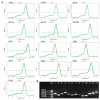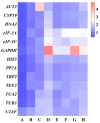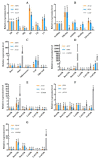Selection of Suitable Reference Genes for RT-qPCR Gene Expression Analysis in Siberian Wild Rye (Elymus sibiricus) under Different Experimental Conditions
- PMID: 31200580
- PMCID: PMC6627066
- DOI: 10.3390/genes10060451
Selection of Suitable Reference Genes for RT-qPCR Gene Expression Analysis in Siberian Wild Rye (Elymus sibiricus) under Different Experimental Conditions
Abstract
Elymus sibiricus, which is a perennial and self-pollinated grass, is the typical species of the genus Elymus, which plays an important role in forage production and ecological restoration. No reports have, so far, systematically described the selection of optimal reference genes for reverse transcriptase quantitative real-time polymerase chain reaction (RT-qPCR) analysis in E. sibiricus. The goals of this study were to evaluate the expression stability of 13 candidate reference genes in different experimental conditions, and to determine the appropriate reference genes for gene expression analysis in E. sibiricus. Five methods including Delta Ct (ΔCt), BestKeeper, NormFinder, geNorm, and RefFinder were used to assess the expression stability of 13 potential reference genes. The results of the RefFinder analysis showed that TBP2 and HIS3 were the most stable reference genes in different genotypes. TUA2 and PP2A had the most stable expression in different developmental stages. TBP2 and PP2A were suitable reference genes in different tissues. Under salt stress, ACT2 and TBP2 were identified as the most stable reference genes. ACT2 and TUA2 showed the most stability under heat stress. For cold stress, PP2A and ACT2 presented the highest degree of expression stability. DNAJ and U2AF were considered as the most stable reference genes under osmotic stress. The optimal reference genes were selected to investigate the expression pattern of target gene CSLE6 in different conditions. This study provides suitable reference genes for further gene expression analysis using RT-qPCR in E. sibiricus.
Keywords: Elymus sibiricus; experimental conditions; expression stability; reference genes; reverse transcriptase quantitative real-time polymerase chain reaction (RT-qPCR).
Conflict of interest statement
The authors declare no conflict of interest.
Figures








Similar articles
-
Selection of suitable reference genes for quantitative real-time PCR gene expression analysis in Mulberry (Morus alba L.) under different abiotic stresses.Mol Biol Rep. 2019 Apr;46(2):1809-1817. doi: 10.1007/s11033-019-04631-y. Epub 2019 Jan 29. Mol Biol Rep. 2019. PMID: 30694457
-
Selection and validation of appropriate reference genes for RT-qPCR analysis of Nitraria sibirica under various abiotic stresses.BMC Plant Biol. 2022 Dec 17;22(1):592. doi: 10.1186/s12870-022-03988-w. BMC Plant Biol. 2022. PMID: 36526980 Free PMC article.
-
Reference gene selection for quantitative RT-PCR in Miscanthus sacchariflorus under abiotic stress conditions.Mol Biol Rep. 2022 Feb;49(2):907-915. doi: 10.1007/s11033-021-06902-z. Epub 2022 Jan 11. Mol Biol Rep. 2022. PMID: 35013862
-
Identification of candidate reference genes for quantitative RT-PCR in Miscanthus sinensis subjected to various abiotic stresses.Mol Biol Rep. 2020 Apr;47(4):2913-2927. doi: 10.1007/s11033-020-05392-9. Epub 2020 Mar 28. Mol Biol Rep. 2020. PMID: 32222917
-
Selection of suitable reference genes for qPCR normalization under abiotic stresses in Oenanthe javanica (BI.) DC.PLoS One. 2014 Mar 20;9(3):e92262. doi: 10.1371/journal.pone.0092262. eCollection 2014. PLoS One. 2014. PMID: 24651080 Free PMC article.
Cited by
-
Validation of Appropriate Reference Genes for qRT-PCR Normalization in Oat (Avena sativa L.) under UV-B and High-Light Stresses.Int J Mol Sci. 2022 Sep 23;23(19):11187. doi: 10.3390/ijms231911187. Int J Mol Sci. 2022. PMID: 36232488 Free PMC article.
-
I Choose You: Selecting Accurate Reference Genes for qPCR Expression Analysis in Reproductive Tissues in Arabidopsis thaliana.Biomolecules. 2023 Mar 2;13(3):463. doi: 10.3390/biom13030463. Biomolecules. 2023. PMID: 36979397 Free PMC article.
-
Screening and validation of optimal real-time PCR reference genes for Abelmoschus Manihot.Sci Rep. 2025 Apr 1;15(1):11045. doi: 10.1038/s41598-025-96110-7. Sci Rep. 2025. PMID: 40169838 Free PMC article.
-
Selection of reference genes for RT-qPCR analysis in developing chicken embryonic ovary.Mol Biol Rep. 2023 Apr;50(4):3379-3387. doi: 10.1007/s11033-023-08280-0. Epub 2023 Feb 2. Mol Biol Rep. 2023. PMID: 36729208
-
Carex muskingumensis and Osmotic Stress: Identification of Reference Genes for Transcriptional Profiling by RT-qPCR.Genes (Basel). 2020 Aug 31;11(9):1022. doi: 10.3390/genes11091022. Genes (Basel). 2020. PMID: 32878033 Free PMC article.
References
-
- Xie W.G., Zhang J.C., Zhao X.H., Zhang J.Q., Wang Y.R. Siberian wild rye (Elymus sibiricus L.): Genetic diversity of germplasm determined using DNA fingerprinting and SCoT markers. Biochem. Syst. Ecol. 2015;60:186–192. doi: 10.1016/j.bse.2015.04.021. - DOI
-
- Wang M.Y., Hou L.Y., Zhu Y.Q., Zhang Q., Wang H., Xia F.S., Chen L.L., Mao P.S., Hannaway D.B. Siberian wildrye seed yield limited by assimilate source. Field Crops Res. 2018;218:18–23. doi: 10.1016/j.fcr.2017.12.022. - DOI
Publication types
MeSH terms
Substances
LinkOut - more resources
Full Text Sources

